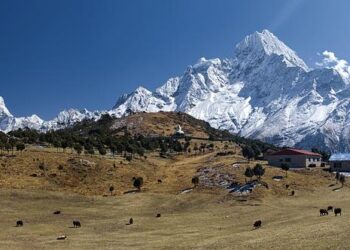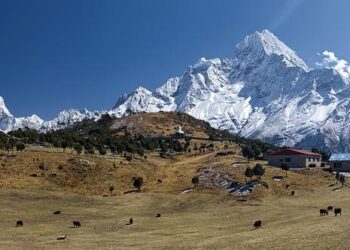A Fresh Take on Nepal-India Relations
In recent years, the intricate tapestry of Nepal-India relations has woven itself into a narrative marked by both historical significance and contemporary complexities. Once viewed primarily through the lens of geographical proximity, cultural ties, and economic interdependence, the relationship between these two neighboring nations is now experiencing a period of re-evaluation and transformation. As political landscapes shift and global dynamics evolve, a fresh perspective emerges, one that seeks to understand the underlying currents shaping bilateral engagement. This article delves into the current state of Nepal-India relations, exploring recent developments, the impact of internal politics in both countries, and the broader implications for regional stability and cooperation. In doing so, we offer insights into how these historically intertwined nations are redefining their partnership in an increasingly interconnected world.
Evolving Political Dynamics Shaping Nepal-India Relations

The political landscape in Nepal has undergone significant transformations, influenced by both internal dynamics and external relationships, particularly with India. In recent years, political instability and shifting party allegiances have often altered the trajectory of Nepal-India relations.Factors such as the rise of nationalism, changing leadership, and evolving public sentiment have redefined diplomatic approaches. Particularly,the emergence of newer political parties has challenged traditional positions,leading to a more assertive stance on issues like border disputes and trade agreements. This evolving narrative reflects the growing desire among the Nepali populace for a more balanced partnership, one that respects their sovereignty while fostering economic cooperation.
Moreover, economic interdependence continues to be a cornerstone of Nepal-India ties, but is now being scrutinized under the lens of national interest. Issues like trade deficits,energy projects,and transit arrangements are now approached with a keener sense of vigilance by Nepali leaders. Recent discussions have highlighted the need for Nepal to diversify its economic partnerships beyond India, prompting a shift towards multilateral diplomacy. This approach not only aims to strengthen ties with nations like China, but also seeks to capture better terms with India, ensuring that the relationship remains mutually beneficial. The focus on collaboration over dominance may pave the way for more enduring and respectful ties between the two nations in the future.
| Factors Influencing Relations | Impacts |
|---|---|
| Nationalism | Increased public demands for sovereignty |
| Political Instability | Frequent shifts in policy direction |
| Evolving Leadership | New diplomatic approaches and strategies |
| Economic Interdependence | Need for balanced trade agreements |
economic Interdependence: Exploring Trade and Investment Opportunities

The dynamics of Nepal and India’s economic interdependence provide a fertile ground for bilateral trade and investment opportunities. As neighboring countries, their economic relationship is characterized by a symbiotic exchange of goods, services, and capital. Some of the promising avenues worth exploring include:
- Hydropower: both nations can harness Nepal’s abundant water resources to generate clean energy, possibly exporting surplus power to India, which suffers from energy deficits.
- Infrastructure Development: India has shown interest in investing in Nepal’s infrastructure—roads, bridges, and airports—which will enhance connectivity and facilitate smoother trade routes.
- Agriculture and Forestry: Collaborative efforts in agro-based industries can boost productivity, especially through technology transfer and investment in enduring practices.
- Tourism: Joint marketing initiatives can enhance tourism, inviting Indian travelers to explore Nepal’s cultural heritage and natural beauty while boosting economic gains for both.
To better visualize the potential economic landscape, the table below illustrates key sectors ripe for cooperation:
| Sector | Investment Potential | Current Initiatives |
|---|---|---|
| Hydropower | High | upper Karnali Project |
| Infrastructure | Medium | Agreements on road construction |
| Agriculture | Medium | Rice and maize research collaborations |
| Tourism | Low | Joint tourism campaigns |
Such collaborative undertakings not only promote economic growth but also strengthen social and cultural ties between the nations. By fostering interdependence, Nepal and India can set a benchmark for regional cooperation, highlighting how strategic partnerships can elevate mutual prosperity.
Cultural Ties and People-to-People connections

The ties between Nepal and India extend beyond borders, deeply rooted in cultural affinities that have thrived over centuries. The shared history is reflected in various aspects of daily life, from vibrant festivals to culinary exchanges. Some key cultural facets include:
- Festivals: Celebrations like Dashain and Diwali are observed with equal enthusiasm on both sides, reinforcing familial bonds and community spirit.
- Language: Hindi and Nepali share linguistic similarities, facilitating communication and cultural gratitude.
- Art and Literature: Cross-border influences in poetry, music, and dance showcase a rich tapestry of shared creative expressions.
People-to-people connections further enhance this relationship, fostering goodwill and mutual understanding. Local exchanges, educational partnerships, and grassroots initiatives play a crucial role in bridging gaps. noteworthy connections include:
| Type of Connection | Description |
|---|---|
| educational Programs | scholarships and exchange programs enable students from both countries to study and share experiences. |
| Cultural Festivals | Joint celebrations highlight the shared heritage,attracting participants from both nations. |
| NGO Collaborations | Local NGOs work together on social issues, strengthening community ties. |
addressing Border Disputes through Diplomatic Engagement

Border disputes have long loomed over Nepal-India relations, creating tension in a partnership that is otherwise rich in cultural and historical ties. Addressing these disputes through diplomatic engagement is not just a necessity; it is indeed an possibility for both nations to strengthen their relationship. Effective dialog and negotiations can pave the way for mutual understanding and shared benefits, yielding the chance to transform conflicts into collaborations. Key to this process are trust-building measures that foster goodwill, including:
- Regular bilateral talks to clarify boundary definitions.
- Joint committees to address local grievances and ensure community representation.
- Public diplomacy initiatives to promote awareness of shared interests.
Additionally, third-party mediation could be explored if bilateral discussions stall, ensuring that both parties feel heard. A framework for conflict resolution that includes international legal standards offers a pathway forward by ensuring that disputes are handled fairly and transparently. A table summarizing the potential benefits of such diplomatic approaches is illustrated below:
| Approach | Potential benefits |
|---|---|
| Bilateral Talks | Strengthened trust and open communication |
| Joint Committees | Local involvement in dispute resolution |
| Public Diplomacy | Increased awareness and support from citizens |
| Third-party Mediation | Neutral perspectives facilitating fair outcomes |
Enhancing Regional Security cooperation for Mutual Benefit

Strengthening regional security cooperation between Nepal and India can serve as a cornerstone for mutual benefit, fostering a sense of trust and collaboration that extends beyond borders. Both nations share a long-standing historical and cultural bond, and enhancing this relationship in the realm of security can considerably contribute to stability in south Asia. Key areas of focus for improved cooperation include:
- Intelligence Sharing: Establishing a clear framework for shared intelligence on cross-border threats can enhance the preparedness of both nations.
- Joint Training Exercises: Conducting regular joint military drills fosters operational compatibility and strengthens the capability of security forces to address regional challenges together.
- Counter-Terrorism Initiatives: Collaborating on counter-terrorism measures can help in tackling extremist groups threatening both countries.
- Disaster Management Cooperation: Natural disasters impact both nations; a unified approach ensures efficient response and recovery efforts.
To facilitate these efforts, it is crucial for Nepal and India to establish a formal mechanism for ongoing dialogues on security matters. Regular meetings can provide a platform for addressing concerns, discussing emerging threats, and deploying resource-efficient strategies. By investing in technology and joint research, the two countries can innovate new security solutions. A potential framework for collaboration could include:
| Collaboration Area | Expected Outcome |
|---|---|
| Border Security Coordination | Reduced smuggling and unauthorised crossings |
| Cybersecurity Framework | Enhanced protection against digital threats |
| Maritime Security | Safeguarded trade routes and resource exploration |
Sustainable Development Initiatives: A Pathway to Strengthened Ties

In the face of emerging global challenges, sustainable development initiatives have emerged as a vital avenue for enhancing collaboration between nepal and India. Both nations share a unique geographical and cultural bond, and by addressing environmental concerns together, they can strengthen these ties. Not only do these initiatives promote green energy and responsible resource management, but they also create economic opportunities that can uplift communities on both sides of the border. By focusing on joint projects, such as forest conservation and renewable energy development, Nepal and India can co-create solutions that benefit their citizens and the environment alike.
Moreover, fostering regional partnerships is essential for addressing issues like climate change and water resource management. Through collaborative programs, such as the following, both countries can achieve their objectives more effectively:
- cross-border Water Management: Joint initiatives for the sustainable management of shared rivers.
- Renewable Energy Projects: Collaborating on solar and hydropower plants to harness clean energy.
- Sustainable Agriculture: Programs promoting eco-kind farming practices and biodiversity conservation.
This cooperative spirit not only enhances the resilience of both nations but also fosters a sense of camaraderie that transcends borders. Strengthening these initiatives will ultimately lead to a more sustainable and interconnected future for Nepal and India.
In Retrospect
the evolving dynamics of Nepal-India relations present a multifaceted landscape marked by both challenges and opportunities. As both nations navigate their intertwined histories and contemporary issues, a fresh perspective rooted in mutual respect, economic collaboration, and cultural exchange is essential for fostering a resilient partnership.The recent diplomatic engagements and regional initiatives suggest a potential shift towards a more balanced and constructive relationship that prioritizes the aspirations of the people in both countries. Moving forward, it will be crucial for policymakers and stakeholders to build on this momentum, addressing historical grievances while embracing a forward-looking agenda that enhances cooperation in trade, security, and connectivity. As Nepal and India stand at this critical juncture, their ability to redefine their ties will not only shape their bilateral futures but will also resonate across the broader South Asian region.

















